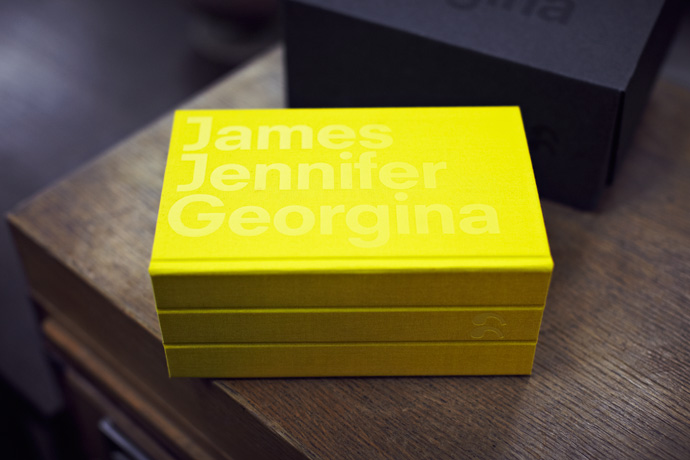1136 postcards and a smoking nun…
One family. One postcard for every day apart. The Butlers’ uncommon journey is told by the postcards from a mother to her daughter.
Collaborating with Dutch designer Irma Boom, Jennifer Butler has published an innovative book: JAMES JENNIFER GEORGINA, a taxi yellow, 1200 pages volume in limited editions of 999 copies, parted in three sections with a joint spine, telling a unique story through 1136 postcards and 20 dialogues.
Jennifer travelled the world with her husband James, in an effort to dry him out from his alcoholism, while their daughter Georgina stayed at home with various nannies, but Jennifer sent her daughter 1 postcard per day away – 1136 postcards written from 1989 to 1999.
205 flights taken, 268,162 miles driven, 2 bullfights.
A speeding ticket.
53 unpaid parking tickets.
13 cancelled flights, 1 bomb scare, and 205 churches visited, politics, wars, rising prices, births, funerals, holidays…
Yet what comes forward above all is their relationship.
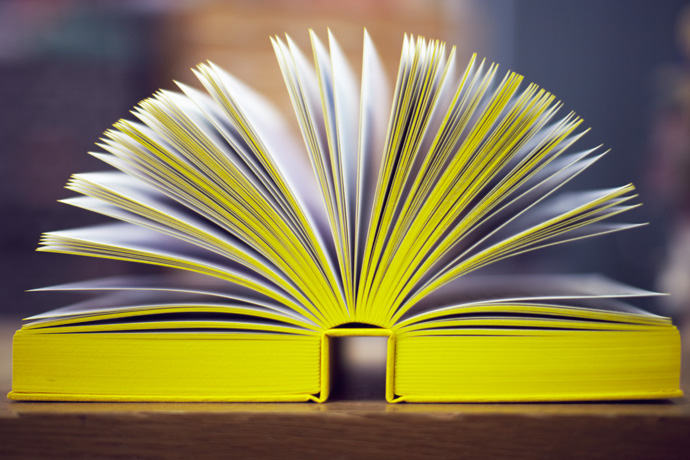 JAMES, JENNIFER, GEORGINA by Jennifer Butler. The 3 spine design allows to lay the book flat
JAMES, JENNIFER, GEORGINA by Jennifer Butler. The 3 spine design allows to lay the book flatWe meet at the American Library in Paris, 23 years after the odyssey started.
As they arrive, Jennifer, a former model, on her side her very British gentleman James, holds a copy of the book in her hands, spiked with post-its of matching yellow. She is in full swing, mentioning another book by Allen Fletcher: “Be aware of wet paint,” he wrote in his beautiful handwriting: ‘I don’t know where I am going, but I am on my way’ and it really sums me up: I don’t know ever where I am going, but I have a sense that I am gonna get there!”.
It was in fact Allen Fletcher’s work, and particularly “The Art of Looking Sideways” that made her look differently at the value of the hundreds of postcards she had kept in boxes after 10 years on the road. When in 1999 the drinking of James stopped, so did the postcards. In 2007, Allen Fletcher was only a few months more to live, so he recommended to Jennifer to work on her project with Dutch designer Irma Boom.
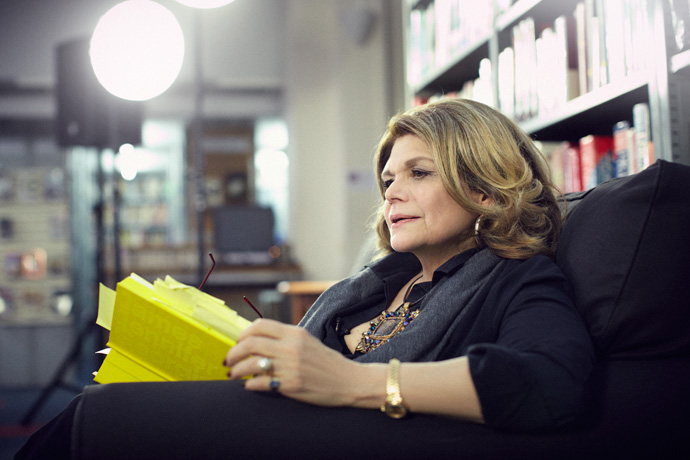 Jennifer Butler at the American Library Paris
Jennifer Butler at the American Library ParisBehind the book, says Butler, lies a passion “for extending the boundaries of what a book can be. And the knowledge that books have to be more, different than ‘information.’ More than being able to download them from the internet” she says. According to her, ‘the book’ is not in the ‘up’ – it’s in the ‘down’:
“The book remains to spread something else: maybe sheer beauty or a much slower, more thought-provoking message” Jennifer expresses in her first correspondence with Irma Boom, sharing the designer’s standpoint on book-making today.
Despite the highly sophisticated and calculated design, JAMES JENNIFER GEORGINA is an emotional matter: “The book is an extension of the content. Irma would not have designed that way for a book about tennis players, or about architecture, whatever. This book is married to the silk screen yellow that she chose, and the yellow canvas. The book is yellow because its full of light and success! […]”
“My husband, Georgina’s father, was drinking himself to death. And with one failed marriage behind me I fought to stave off a second.” James was given only two more years to live, so “to save us I took the difficult decision to leave Georgina at home. We travelled to dry James out and we travelled to shield her from the indignities of drink. Everyday we were apart I wrote to Georgina. If love waits upon a gesture, then my gesture was these postcards. I wanted her to know just who I was and just what I did. They’re a testament to a mother’s love and a sharing of advice, anecdotes, front page news and exotic places” she explains.
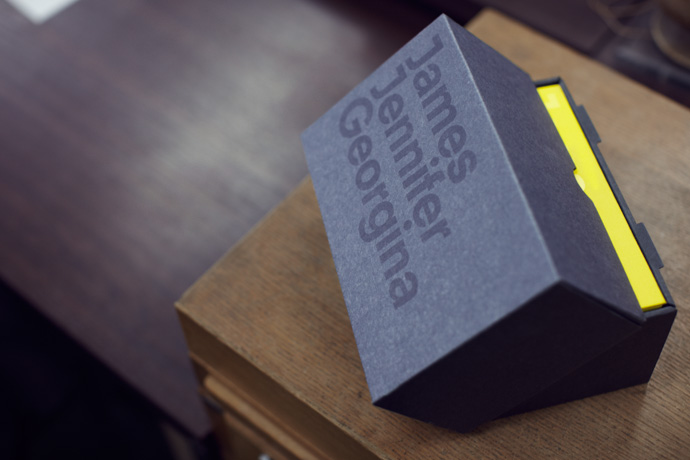 Cassette with the Book of 1200 pages, sewn in yellow cloth
Cassette with the Book of 1200 pages, sewn in yellow cloth“The post cards were never written for public consumption. They were written because I loved doing them.
And I did miss Georgina. And I did feel guilty and it was a way, felt like mothering from a distance.”
For Jennifer, it is actually a very traditional story: “there is a situation, a lot of descriptions with the postcards of a story, there is drama and there are 3 characters. They’re just divided in a very innovative way, because the description and the situation is part 1, the drama is part 2, and the characters are in an album in part 3. Usually when you read about a family or a story or a novel it’s all in one. […] ” She continues, “when people hear the word alcoholism – you know its like a dirty word or somebody survived it. The alcoholism really gave the book its Alfred Hitchcock time element.”
Jennifer admits that there was certainly a bit of irresponsibility concerning the traveling, looking back on it:
“The structure was: let’s go. Like Thelma and Louise. And I was so excited having James sober and clean shaven! He was adorable and generous and he is so knowledgeable about Europe, its history and its wars. It was like being back in university when we were driving! And there was no drink. Because he was so excited being on the road. So it really was not just about keeping him sober. He was sober and I loved the way he was.”
 Postcard from Granada, February 10, 1996
Postcard from Granada, February 10, 1996The book is framing this story of longing guilt and salvation for a wider audience in a fresh way. Despite the 210 postcards that are printed full bore in the volume, accompanied by 400 in miniature, most remarkably, the book also features a series of conversations between James, Georgina and Jennifer: “One guideline that Georgina said, and James backed her 100% up was: there would be no editing! […] “
Irma Boom, according to Jennifer, had approached the book with an enormous integrity and much love for its protagonists had insisted “that we pose the question to Georgina in one of the conversations: what was the sacrifice made by not being there. I said: ‘oh, isn’t this fantastic, Georgina spends every night looking at them.’ My mother said: ‘this is disgusting! my granddaughter is alone a third of her life!’ – of course the people who love you tell you the biggest truths.”
“It was never ever difficult [to talk about our issues as a family]. We’re all very strong characters and I think the love is so loyal that nobody worried about sacrificing love. It was never difficult to talk about the painful subjects: most of all it’s a love story.”
<pre>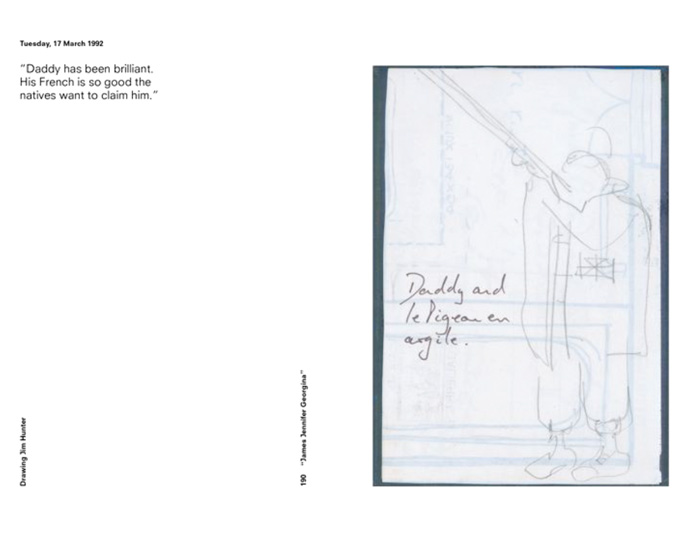
“Daddy has been brilliant. His French is so good the natives want to claim him.” postcard from March 17, 1992
The [conversation] number 17, the ambush in fact, really laid to rest the most painful experience other then my adoption in my life. I was adopted. And I think one of the reasons why I married James, unconsciously, was that he came from this family which dated back from the doomsday book. And he never humiliated me or said anything.”
Jennifer recalls being on a bus in Elmira, in upstate NY, where she grew up- and the bus was about to go by where she lived at the time, when she heard a woman saying: ” ‘Oh yes, that’s where Dr. Gladstine’s adopted daughter lives” and the woman she was sitting with said “Oh, I wonder why Mrs. Gladstine couldn’t have any children.” Again these details inspired me to be a writer. I needed to get this horror on paper, but I still feel an outsider. It’s still an ulcer and very sore point. But I accept it more now, I am not so angry. It’s hard to be adopted, you wonder why your mother could not handle it.”
“Growing up in a small town where gossip had the most real estate value, you become very observant. And I had big ears!”.
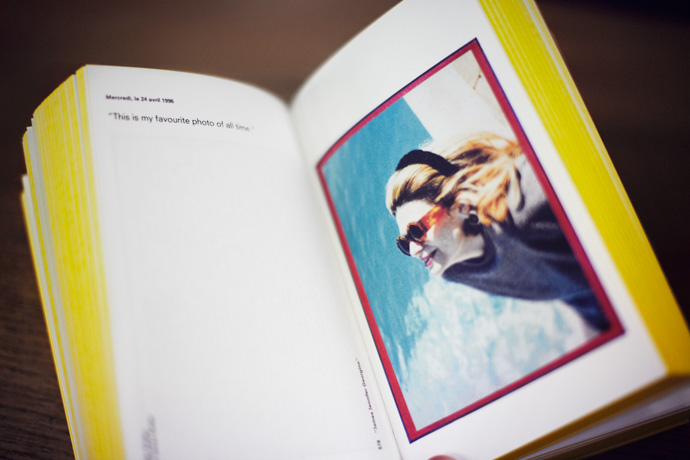 "This is my favorite photo of all time" postcard from April 24, 1996
"This is my favorite photo of all time" postcard from April 24, 1996She witnessed another incident, that she describes us. Being about seven, she was walking home from the playground: “I saw sister Ignacious who was the head sister at Saint Joseph’s Hospital where my father was chief of staff – and she was smoking a cigarette! With her elbow outside the window of the station wagon she was driving – and I could not wait to get home to describe… it just seemed inappropriate for a nun to be smoking a cigarette and be driving with one hand! like the teenagers were doing.”
This impression still inspires her, and is probably one of the reasons that brought her to writing and yielded to a correspondence with Simone de Beauvoir she wrote to me “Vous avez beaucoup de talent” — I was thrilled! I slept with the letter! I still carry it around with me!”
In 1959 she won the New York State historical society contest in writing an essay about a village called Horseheads, NY, and the reason of how it came to be called that. “I won 50 dollars! that was an enormous amount of money to a kid!” she says.
Jennifer had laid aside another novel she was working on before James, Jennifer, Georgina:
“Fuji Views”, that she stopped mid-stream, halfway through with about 100 chapters, using the structure of the views: “you know how it’s to write like a train – and I just stopped. In fact I was talking about Joanne, the main character yesterday. It’s definitely on a front burner.”
We ask Jennifer to tell us a little about the Postcards themselves: “Of course I hated choosing 210 of 1136 postcards. it was like abandoning the things I’d written and loved. As Steinbeck would say: “get rid of all the pretty little things.”
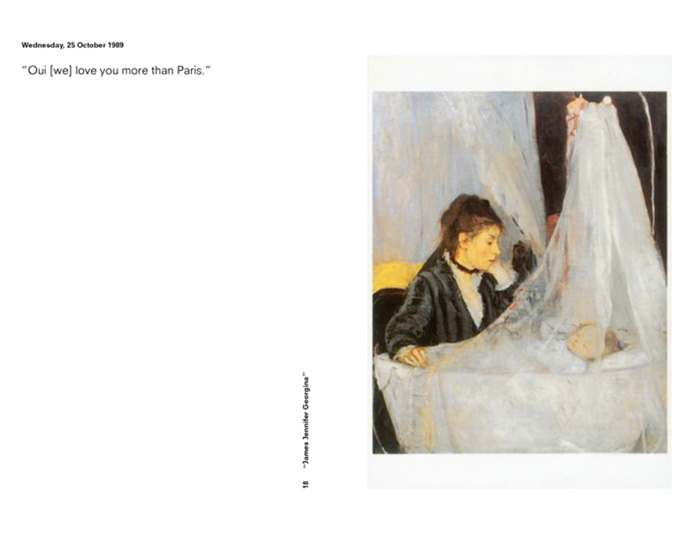 The first Postcard to Georgina, from October 25, 1989
The first Postcard to Georgina, from October 25, 1989“This is the opening one and it says: “Oui love you more than Paris”- And the “we” is spelled “Oui” its a postcard of a painting of Berthe Morisot of a mother looking at her baby in a cradle. Georgina would have been four months old at that time, and she would not have come home from the hospital until she was three months old because she weighted not even a kilo when she was born. So this was the first postcard that I wrote to her. We didn’t travel while she was in hospital.”
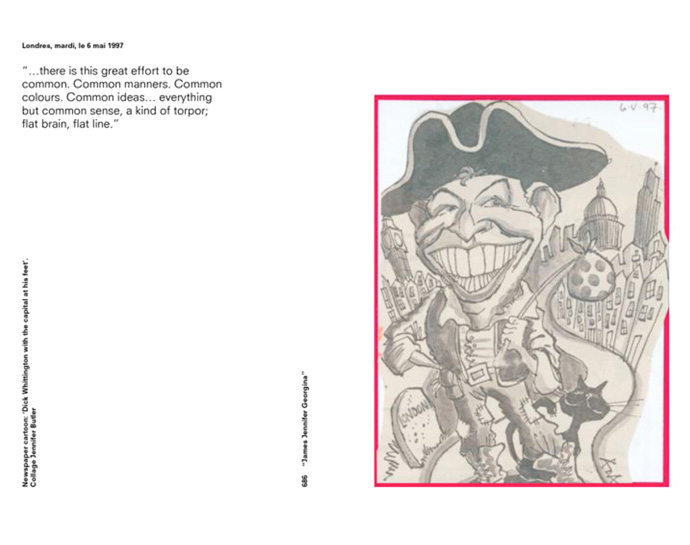 Postcard from London, Mai 6, 1997
Postcard from London, Mai 6, 1997“I like this one: ” there is a great effort to be common, common manners or common collars, common ideas, everything but common sense. a kind of tore-poor. flat brain, flat line” and its a cartoon of Tony Blair.”
 Postcard from March 22, 1998
Postcard from March 22, 1998“At the end when things were really deteriorating – it’s bad. You know I am taking Prozac and I definitely say ‘this has got to stop!’ James cried when he re-read all the postcards in the last few days.”
The last Postcard from December 11, 1999
“I love the stamp! it reminds me of Rothko, who is one of my favourite artists, because he makes me calm. The last postcard was not chosen because what it said, it was by chance. Because this book has been cosmic and there been a lot of luck. It says, ‘is there is an old french proverb translated: “the simpler the explanation, the closer the truth.” And it’s true.”
“This book, is really a very simple book. When you think, its postcards, they are usually such a cliché, they are so ordinary. One would not be interesting, but 1136 were hugely interesting!
One reason why I chose, that I knew why Allen Fletcher had recommended Irma, was because I didn’t like Helvetica. You’re laughing! It’s not that i dislike Helvetica- I understand Helvetica and it’s very clean and very accessible, but I hate the G’s !
And if you look at my handwriting, you know my handwriting is unique to me. As Georgina said “I simply have tried a thousand times to forge your signature and I can’t!” and the way I write physically and the pen that I use is always been incredibly relevant to what I write. And I still write long hand I don’t write on the computer. So yes, its Palatino and Neuzeit.
I love the questions that she asked and that she allowed me the arguments. We had passionate fights were we didn’t talk to each other for several days. She would TNT the book with all of these post its. And then on my computer there would be a magenta line which meant: “I don’t like this – fix it!
We communicated and we never signed our emails. Our motive communication was that we didn’t put the X for “love” at the end- that was: ‘I hate you at this moment.’ and we both used it. We both developed a culture and a vocabulary between our selves working together.
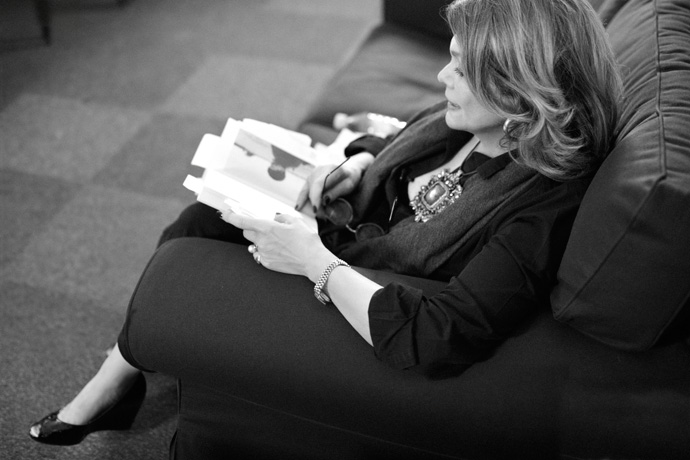 Jennifer Butler at the American Library Paris
Jennifer Butler at the American Library ParisOne of the 1136 Postcards written to Georgina was addressed to Jennifer – from James.
And here they sit at a table late at night, engaged in conversations to different directions but holding hands across an empty chair of someone left earlier, Jennifer mentions the books impact to her personally:
“I would never have learned so much about our marriage and our relationship if I didn’t have it a year and a half later to read. All these moments would have been forgotten if the postcards wouldn’t have been written. And the photographs — I would have forgotten whatIi looked like when I was a young girl!
All these things…. it’s not a tragedy that I am old, because I have the evidence of what it was like to be young. I would not want to be that age again. I made so many mistakes! And my husband thinks I am gorgeous – and he tells me everyday…”
Jennifer Butler (Text)
Irma Boom (Concept & Design)
Erwin Olaf (Portrait Photos)
London/Amsterdam 2010
Yellow cloth sewn/in cassette 1200 pages
Unique binding method with coloured edges
Full colour illustrations
Text in English
Edition limited to 999 copies
Price: € 999.00
